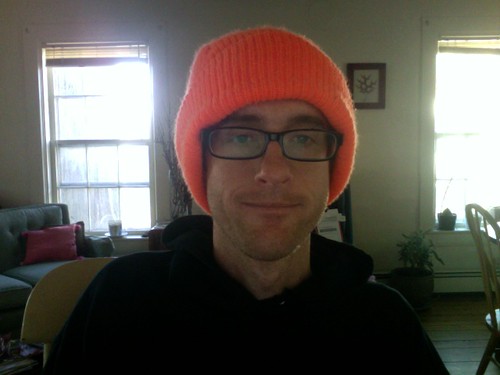That's right - it's that time of year where most people outside in Vermont are going to start wearing clothes that are brighter orange than the few maple leaves still clinging to the trees. Rifle season for deer hunting starts tomorrow. Most people heading out into the woods wear a bright orange hat and/or vest, so they aren't accidentally mistaken for a deer. If you're heading out for the next few weeks, you should wear a silly orange hat, too. The last day of rifle season in Vermont is November 27th. Muzzleloader season in Vermont is December 3 - 11. Because these guns have a much shorter range than rifles, mistaken identity issues are less likely, but it's still a good idea to wear orange just in case.
Each state has a somewhat different hunting season, so check with your local fish and wildlife department for more info, if you don't already know.

See below for more thoughts on deer hunting and watershed health.
Hunting season doesn't seem like something particularly relevant to 'slow water', but in fact it can be very relevant, albeit indirectly. I recently posted about how important plants (especially trees) are to maintaining healthy, meandering river channels. The number of deer is strongly linked to whether or not forests are able to regenerate. Since the ice age, the main predators for deer in most of North America were wolves, mountain lions, and humans. These days, wolves and mountain lions have been extirpated from much of their historic range, and in many cases, humans aren't having as much an effect on the deer population either, at least not as hunters. Instead, many deer die of starvation, or in collisions with vehicles that also can result in injury or death to the human vehicle occupants. Deer overpopulation may also be leading to an explosion in the tick population and thus an increase in Lyme disease. Overpopulated deer may also be vulnerable to diseases such as chronic wasting disease (the deer version of mad cow disease)
I'm not sure if deer overpopulation is an issue in Vermont, but there are some indications it may be in some areas, particularly the Champlain Valley. Other areas further to the south and west, such as Pennsylvania, are experiencing severe deer overpopulation. The areas with the biggest problem are those where there aren't humans hunting deer either - such as in and around cities and suburbs. For instance, the four large, forested parks in Pittsburgh are having an issue with overpopulated deer decreasing seedling survival and diversity. These changes in turn can result in loss of forest cover, soil erosion, and other issues that can negatively affect forest health.
Unfortunately, most hunting regulations were designed to increase deer population, something that was important in the past but is now detrimental. Hunters tend to go after big bucks, but since it takes only one remaining buck to impregnate many dozens of does, hunting bucks doesn't have a strong effect on deer population. In many places, however, doe tags are now being offered. While some hunters are reluctant to shoot does for a variety of reasons, doing so will help control deer population, while still providing high-quality meat. Most meat consumed in this country comes from stockyards, and its production requires a large expenditure of resources, but in this case, you will be having a net positive benefit instead!
So, if you live in an area with too many deer, consider getting a doe tag. I haven't tried deer hunting, and don't own a rifle or bow, so I won't be out there this year... but some of my friends will be and I hope someone gives me some venison (hint, hint...)
In areas of very dense human habitation, such as Schenley Park in Pittsburgh, it isn't a good idea to have people out with rifles hunting deer. However, other cities have implemented short bowhunting seasons (where parts of parks were closed to the public), and meat harvested by skilled bowhunters is often donated to homeless shelters. It can be hard for local residents to support hunting of deer they have watched living around their homes (unless they are losing their gardens to the deer...) but if you're one of these people, consider that starving to death or being crippled by a car, likely alternatives for overpopulated deer, are much more inhumane than an arrow to the heart.
Also, while it isn't directly relevant to this post, it's Veteran's Day, so I do want to thank our veterans for fighting to protect us so we experience free speech as in the case of this blog... regardless of our personal views on the current government/system, I still feel that it's important to remember and thank our veterans. Thanks!

What a great written and funny true story about hunting. The camouflage clothes , the painted faces, and a bright orange hat. Hide from the deer as much as possible, but let hunters see you. I hunt at www.peartreegameranch.com and orange hats are everywhere. Still funny to think of all those orange hats.
ReplyDeleteThanks for the post! The orange hats are a big part of late fall Vermont culture (as I am sure they are in most other places deer hunting occurs). Apparently you can't wear orange when turkey hunting, though, because unlike deer they are not colorblind, and you'd never get anywhere naer a turkey dressed like that... or so I hear. Good luck out there!
ReplyDeleteInteresting blog. This is one of my favorite blog about hunting and I also want you to update
ReplyDeletemore post like this. Thanks for sharing this article.
Rifles Guns in Australia